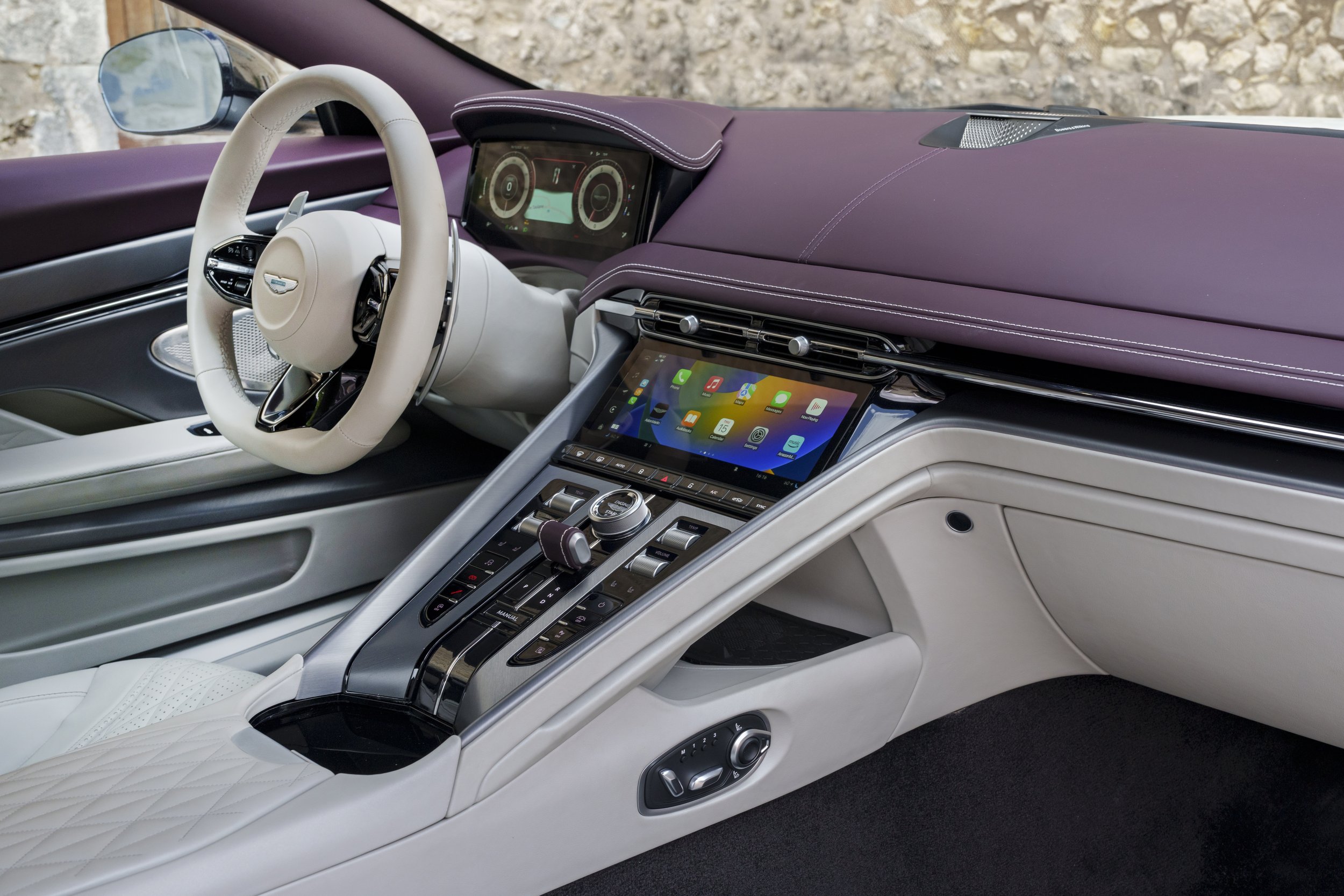CAR LAUNCH: Aston Martin DB12.
Is the new DB12 the car that finally allows Aston Martin to take on the likes of Ferrari? Steve Sutcliffe drives it on the Route Napoleon in search of answers.
WORDS: Steve Sutcliffe
Aston Martin is on a roll right now, no doubt about it. On the race track, and in Formula One especially, the results just keep on rolling thanks in no small part to the genius of Fernando Alonso Diaz. And on the road the cars speak for themselves nowadays, none more so than the brilliant new 202mph, £185,000, 671bhp DB12.
This is no coincidence, however. Behind the scenes much has changed at the 110 year old British sports car company since the lows of the pandemic. New boss Lawrence Stroll has been quietly restructuring and refinancing the company – to a point where there is now both the talent and budget to take on Ferrari at its own game: the company’s new CEO Amedeo Felisa, for instance, used to do the same job for the Scuderia, overseeing the creation of such luminaries as the 458 Italia and the F12 when he was at Ferrari, so he knows a thing or two about how to make great road cars.
And now everything is falling neatly into place at Aston Martin, and the brilliant new DB12 is very much the car that proves it. For starters, it looks knee-tremblingly beautiful in the flesh, with a profile that’s quite beautiful on its own, plus a front end that looks every inch as arresting as that of the One-77 on which it’s unashamedly based.
Beneath its long and equally dramatic new composite bonnet, the DB12 is powered by a heavily reworked though still AMG-sourced 4.0-litre twin-turbo V8 engine which, in this case, has been tuned by Aston to produce 671bhp and a thumping 800Nm. Gone is the V12 of the DB11, in other words, but in reality this matters not one iota because, if anything, the V8 has more personality to it than the old Ford-sourced twin-turbo V12 ever had.
In any case, compared with its AMG installation the V8 has new turbos, different cams, a new induction system, a completely different exhaust system and, of course, home-grown mapping to give it both a feel and soundtrack that’s entirely bespoke. In practice, it has so much more character and thrust in the mid to high ranges, and sounds so different to an AMG, you’d be hard pushed to identify its roots.
The gearbox is an eight-speed paddle shift auto by ZF (so not the 9-speeder from the DBX 707, which wouldn’t fit) again with entirely bespoke mapping to give it a feel and shift quality (plus numerous drive modes) that are unique to the DB12. Drive then reaches the enormous (and also bespoke) 325 section, 21in rear Michelin PS5S tyres via a fully electronic diff that will, as you can see, allow you to do all sorts of silly things for the cameras on a closed road. But also generate a tonne of traction on any road, with or without the electronics engaged.
All up the DB12 weighs 1685kg, claims its engineers, but only if you specify each and every one of the numerous lightweight options including a pair of Carbon Performance seats. In regular guise it weighs just over 1700kg, so about the same as the outgoing DB11, which isn’t bad considering how much more highly specified it is inside and out, and how much more tech it contains. Aston claims it can hit 62mph from rest in 3.6sec with launch control (3.3sec to 60mph) before reaching a top speed just the other side of 200mph. So, it’s seriously quick for a so-called ‘super tourer’ even though it can’t quite match the outrageous acceleration of the DBX 707 due to it being rear, rather than four wheel-drive.
No matter, because the DB12 isn’t meant to be a tyre-shredding hot rod in a straight line, even though it kind of is. Instead, it’s designed to carry you across continents with breath taking pace and refinement, enabling you to arrive at your destination in more style and charisma than pretty much anyone else who pulls up at the valet parking area. James Bond was born to drive a DB12, or maybe it’s the other way round. Either way, this car oozes panache in a way that no recent Aston has ever quite managed to replicate. Not just because of the way it looks, although inevitably this plays a key role.
On the RN85 – the famous Route Napoleon – the DB12 feels soothing and effortless but also rabidly fast, the twin-turbo V8 providing a level of thrust from 2000rpm onwards that, in any of the first five gears, is deeply seductive. It feels and sounds MUCH quicker – and naughtier – than the DB11 did at any revs, in any gear, never more so than in Sport+ up at 6500rpm.
Then, the exhaust gets a lot louder, the body control goes up a notch and the steering feels crisper. As does the way the diff and gearbox respond. Switching from Comfort through Sport to Sport+ exacts a transformation in the DB12 that’s as impressive as it is wide-ranging, and it gives the car a huge breadth of ability, even if you’re best off running in Sport for most of the time, with a switch to Sport+ being just a simple wrist-flick away.
In everything it does on the move, the DB12 is just a hugely more capable car that the one it replaces, and sometimes in ways you’d not necessarily expect. The interior on its own makes it feel like a far more expensive and luxuriant grand touring car than the 11, and it isn’t just the on-board tech that impresses, either. The cabin itself has been completely redesigned both visually and logistically, and the end result is spectacular.
As such, zero excuses are now required once you climb aboard the DB12. Good car though it was, you could never sincerely say that about its predecessor. You tend to gasp quietly to yourself about how lovely the 12 is inside, and how high in quality everything seems, in much the same way you do when you climb aboard a contemporary Ferrari. You can also see out of it far better than you could its predecessor, thanks to a combination of bigger, better-designed door mirrors, a slightly lower scuttle at the base of the windscreen plus lighter, fresher styling for the upper reaches of the dash.
Yet it’s on the move where the biggest changes have taken place. Dynamically the DB12 has a much more cohesive feel to it compared with the DB11. Its steering, chassis, engine response, brake feel, diff behaviour – everything it does on the move – all have a new-found sense of polish and focus to them that, when taken as a whole, make it way better to drive. And the DB11 was no dud, remember.
It's also breathtakingly fast on give and take roads. From the extra noise it makes under full load to the thundering acceleration it delivers in fourth and fifth gears, let alone second and third, the DB has become a seriously good driver’s car. Yet it’s also deeply refined when you want it to be, with a dynamic calm and clarity that always eluded the DB11 somehow. Bottom line; it’s now as sharp to drive as it is luxurious just to travel in; as thrilling as it is soothing. As a combination that makes it hard to beat once you factor in all its other new-found core strengths.
Issues? The gearshifts are fine in the regular modes but could be snappier in Sport+ mode to get anywhere near those you’ll experience in a dual-clutch Ferrari; the manual gear indicator graphic could be a touch bigger within the instruments; there were a couple of tiny fizzes from the centre console in the pre-production car I drove; and the rear seats remain fairly cramped for humans of any size.
But overall the DB12 is just a great car, an outstanding one in many ways. It’s as lovely to drive as it is to look at, which is saying something, plus it has a fantastic new cabin that’s far higher in quality than any other Aston Martin in history. It deserves to succeed, and it will. And remember, this is just the beginning. The really good stuff is yet to come. Excited? You bet.
Verdict – The DB12 is better than its predecessor in every measure. Aston Martin is back on top of the GT car game with a car that will keep the competition looking over its shoulders.










